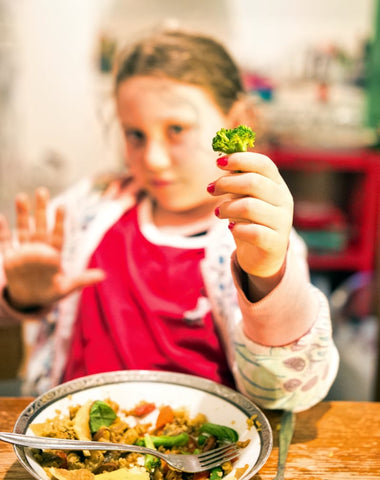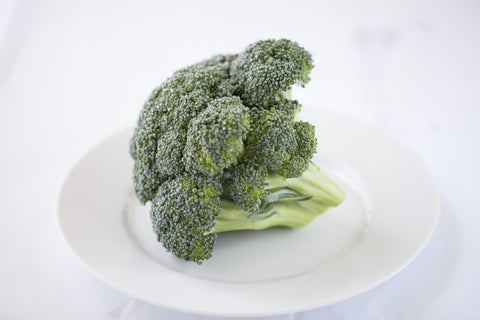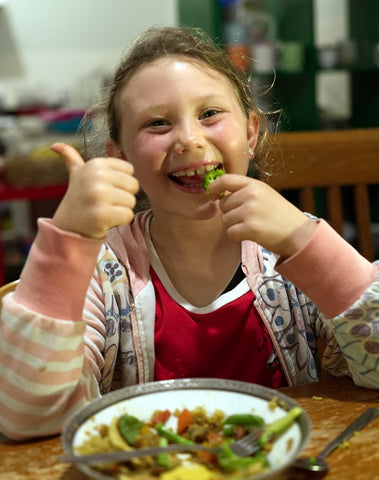How to create healthy, happy, food-loving kids : Tribal Food and Fussy Eaters
Guest blog written by Gareth Vanderhope :: Children’s Author, Health Educator, Sound Designer, Dad. Connect with Gareth on Instagram or through his website
The well-intentioned parent
You lovingly prepare a nutritious, yummy meal and your child says, ‘Yuk, I don’t like it!’ Thud. Your head lands on the table. Devastated, bemused and desperate, you resort to scare tactics: ‘You need to eat broccoli, it prevents cancer!’ And if that doesn’t work, there’s the emotional blackmail: ‘Kids are starving in Africa, you know. They’d love to eat this meal, I’m sure.’ Then the big guns – the threatening bribe: ‘There’ll be no ice-cream if you don’t eat your lettuce!’
\
Despite your well-delivered, award-winning performance, your child says, ‘I don’t care. I don’t even want ice-cream!’ Huh! What? Dumbfounded, you may raise the stakes by shouting, or you lower the stakes by offering cheese on toast, much to the delight of your child.
With the dust now settled, calm returns to the dinner table, albeit with nerves frayed, and you worry silently whether your child will become nutritionally deficient or sick from such a restricted diet.
The role of evolution
Conventional wisdom from nutrition research tells us that it’s normal for kids to be fussy eaters. They have heightened taste, so those strong veggie flavours hit them like a Mack truck. Fussy eating also makes sense from an evolutionary perspective. Food cautiousness in children over the age of three may be a handy protective mechanism to prevent them from eating a poisonous bush morsel.
Early programming
Early exposure to certain foods may also play a role in children developing a varied palate. For example, friends of mine prepare vegetarian meals full of beans, veggies, herbs and spices, which their kids gulp down without fuss. Luck? Genetics? Perhaps not. Research shows that a mother’s diet influences the taste of her amniotic fluid and breast milk. Children are therefore pre-programmed to accept those flavours later. Breast milk, infused with Kaffir lime, green beans and eggplant. Delicious!
That’s all well and good, but how do I get my child to eat broccoli NOW, you may ask?

First, let’s explore the standard advice for encouraging fussy kids to eat healthy food.
Keep things calm, happy and sociable at the dinner table.
- Stress impedes digestive juices and wipes out a child’s appetite, while calmness and happy social interactions get the juices flowing.
Never force your child to eat healthy food.
- Way too stressful for everyone and can lead to an intensified refusal of that food. Gentle encouragement is advised, however.
Avoid watching TV while eating dinner.
- Not only does this allow for happy social interaction, but it also provides an opportunity for you to lead by example. ‘Mmmm, this salad is soooo good! These walnuts are so creamy!’
Make healthy foods fun.
- Games work well in my family. ‘Hey, who can crunch their corn the loudest? Crunch! Crunch! Crunch! Before you know it, your fussy eater is a corn-munching maniac.
Avoid restricting foods based on past refusals.
- ‘Oh, don’t bother serving beans to Sunny, he doesn’t like them.’ A better approach is to keep offering previously refused food as it can take 15 or more tastes before a new food is accepted. One day, you might be surprised when the plate is empty. In the meantime, save the leftovers for soups and veggie fritters.
- Allow your child to play with food. Although this goes against parenting instincts, research shows that play can ease a child’s fear of new foods.
Let’s get real – alternative meals are inevitable, right?

Although the above tips are useful, every parent of a fussy eater knows that when a child refuses a meal, it’s difficult not to offer an alternative choice – a special meal. So what do we do? Do we go old school and send our child to bed hungry? Kids won’t starve themselves, right? Wrong.
Research shows that kids who are not offered a special meal are more likely to become underweight or malnourished. Deficiencies of nutrients like zinc reduce taste, appetite and digestive capacity, leading to a worsening of food intake. In rare cases, children have been hospitalised for malnutrition. ‘Okay, come back. I’ll make you vegemite toast! Or would you prefer jam?’
The problem with alternative meals
Children who are offered alternative meals are more likely to have restrictive diets, which may persist into adulthood. Alternative meals are often nutritionally inadequate and high in refined carbs, fats and salt – clearly bad for health.
Alternatives to alternative meals
- Rather than making a special meal, offer a range of healthy foods at the dinner table, including the types you know your fussy eater likes. So whatever he or she chooses is nutritious.
- Continue to serve some non-favourite foods on their plate (e.g. salad). This provides an opportunity for experimentation. Start with separate elements such as carrot sticks and a lettuce leaf. Kids are more likely to try these foods when not mixed, and exposure to the colour and smell are important steps in the acceptance process.
- Healthy desserts can be nutritious and yummy. ‘Who’s ready for some low GI, gluten free, blueberry and ricotta hotcakes?’ (Visit my website for that one!).
- Get your fussy eater involved in cooking. They love the hands-on experience, and it gives them ownership and pride in the meal.
- Above all, use your common sense. Don’t allow your child to become underweight. Seek professional advice if required.
Tribal food is the key
Tribal food could be thought of as the cuisine that a child perceives as normal within his or her community. So a child growing up in India will accept curry for breakfast. A child growing up in a vegetarian family will learn to accept vegetarian choices as the norm.
For many of us, our tribal food culture is ill-defined and inconsistent. A trip to the grandparents and all bets are off. A shared meal with friends, whose kids will only eat margarita pizza, results in your kids refusing to eat any other type of pizza in the foreseeable future. Frustrating!

According to research, these tribal influences do indeed affect the food choices of children. A colourful uncle, chowing down beansprouts and hanging them from his ears may actually help children accept these foods, and the effect can be long term.
So to create healthy, happy, food-loving kids, get the whole community involved and create your healthy tribe!

More on that next time ... click here to get the free recipe
Guest blog written by Gareth Vanderhope :: Children’s Author, Health Educator, Sound Designer, Dad
Connect with Gareth on Instagram or through his website
References
Asakawa, A., Li, B., Tsai, M., & Amitani, H. (2011). Zinc as an Appetite Stimulator - The Possible Role of Zinc in the Progression of Diseases Such as Cachexia and Sarcopenia, 226–231.
Hendy, H. M., Williams, K. E., Riegel, K., & Paul, C. (2010). Parent mealtime actions that mediate associations between children’s fussy-eating and their weight and diet, 54, 191–195. http://doi.org/10.1016/j.appet.2009.10.006
Pujol, J. (2016). Fussy eating in children down to genetics. How long should children play?, (November).
Rioux, C., & Picard, D. (2016). Food rejections in children: Cognitive and social / environmental factors involved in food neophobia and picky / fussy eating behavior, 96. http://doi.org/10.1016/j.appet.2015.09.008


